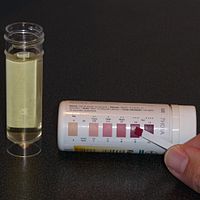
Photo from wikipedia
Purpose Glioblastoma (GBM) remains one of the most lethal primary brain tumors in children and adults. Targeting tumor metabolism has emerged as a promising-targeted therapeutic strategy for GBM and characteristically… Click to show full abstract
Purpose Glioblastoma (GBM) remains one of the most lethal primary brain tumors in children and adults. Targeting tumor metabolism has emerged as a promising-targeted therapeutic strategy for GBM and characteristically resistant GBM stem-like cells (GSCs). Methods Gene expression data was obtained from the online patient-histology database, GlioVis. GSC mitochondria morphology was examined by TEM. Cell viability and effect on GSC self-renewal was determined via MTS assay and neurosphere assay, respectively. Proteins were evaluated by Western Blot. Results Enzymes necessary for ketone catabolism (BDH1, OXCT1 and ACAT1) are significantly downregulated in adult and pediatric GBM. GSC mitochondrial ultrastructure suggested defects in oxidative phosphorylation. Treatment of both GBM and GSC cell lines resulted in dose-dependent decreases in viability in response to glycolytic inhibitor 2-deoxy-D-glucose (2-DG), and ketone body Acetoacetate (AA), but not β-hydroxybutyrate (βHB). AA induced apoptosis was confirmed by western blot analysis, indicating robust caspase activation and PARP cleavage. AA reduced neurosphere formation at concentrations as low as 1 mM. Combined treatment of low dose 2-DG (50 μM) with AA resulted in more cell death than either treatment alone. The effect was greater than additive at low concentrations of AA, reducing viability approximately 50% at 1 mM AA. AA was found to directly upregulate mitochondrial uncoupling protein 2 (UCP2), which may explain this potential drug synergism via multi-faceted inhibition of the glycolytic pathway. Conclusion Targeting the metabolic pathway of GBM via glycolytic inhibition in conjunction with ketogenic diet or exogenous ketone body supplementation warrants further investigation as a promising adjunctive treatment to conventional therapy.
Journal Title: Journal of Neuro-Oncology
Year Published: 2020
Link to full text (if available)
Share on Social Media: Sign Up to like & get
recommendations!